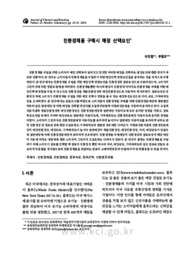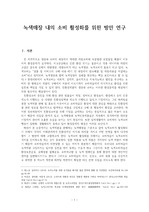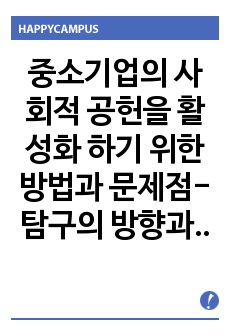

PARTNER
검증된 파트너 제휴사 자료
친환경제품 구매시 매장 선택요인 (Store Choice Factors for Purchasing Green Products)
한국학술지에서 제공하는 국내 최고 수준의 학술 데이터베이스를 통해 다양한 논문과 학술지 정보를 만나보세요.
31 페이지
최초등록일 2025.07.11
최종저작일
2018.01

-
미리보기
서지정보
· 발행기관 : 한국유통학회
· 수록지 정보 : 유통연구 / 23권 / 1호 / 25 ~ 55페이지
· 저자명 : 이인영, 주영진
초록
친환경제품 구입을 위한 소비자의 매장 선택폭이 넓어지고 있지만 이러한 매장을 선택하는 결정요인에 대한 연구가 부족한 상황이다. 본 연구는 소비자들이 친환경제품을 구입하기 위한 매장선택 영향요인들을 분석하는 것을 목적으로 수행되었다. 본 연구에서는 친환경제품 구입을 위한 매장선택 영향요인을 친환경성과 점포속성으로 구분하였으며, 소비자의 그린의식에 의한 영향도 함께 분석하였다. 친환경제품뿐만 아니라 매장의 친환경적 이미지도 친환경제품 구매를 위한 매장선택에 영향을 미칠 수 있으므로 친환경성을 제품친환경성과 매장친환경성으로 구분하여 제시하였다. 점포속성은 친환경성 외에 소비자가 친환경제품 구입을 위한 매장 선택시 영향을 줄 수 있는 매장특성요인으로 거리, 규모, 가격매력도 등을 고려하였다. 본 연구에서는 설문조사를 바탕으로 소비자들이 친환경제품 구매를 위해 친환경전문매장과 대형할인마트와 같은 일반매장 중 어떤 매장을 선택할 것인지를 조절회귀모형과 이항로짓모형을 이용하여 분석하고 있다. 조절회귀분석결과 제품친환경성과 매장친환경성은 친환경전문매장과 일반매장 이용의도에 모두 유의한 영향을 미쳤고, 점포특성요인들 중에서 거리와 매장규모는 일반매장 이용의도에, 가격매력도는 친환경전문매장 이용의도에 유의한 영향을 미쳤다. 소비자의 그린의식은 친환경전문매장 이용의도를 유의하게 높이거나 일반매장 이용의도를 유의하게 낮추는 반면 친환경성 및 점포속성에 대한 조절효과는 가격매력도와 결합된 경우에만 나타났다. 이항로짓분석결과 친환경전문매장의 매장친환경성, 매장규모, 가격매력도가 높거나 일반매장의 제품친환경성, 매장친환경성, 거리, 매장규모가 낮을수록 일반매장에 비해 친환경전문매장이 유의하게 선호되었다. 친환경제품 구매매장의 친환경성과 점포속성이 해당 매장의 이용에 미치는 영향력에 대한 소비자의 그린의식 조절효과는 나타나지 않았다. 본 연구의 결과는 친환경제품을 구입하기 위해 소비자가 점포를 선택할 때 점포의 친환경성 뿐만 아니라 거리, 매장규모, 가격매력도와 같은 점포속성들도 중요하게 작용함을 제시함으로써 친환경제품을 취급하는 점포의 소매마케팅전략 수립에 의미 있게 활용될 수 있을 것이다.영어초록
Previous studies on green marketing have largely focused on green products and green consumers: defining a green consumer, exploring precedents and consequences of the green consumption, and answering who and why purchase a green product. Traditional channel to access green products is limited to the green & organic specialty store. However, as many retailers deal the green product, consumers can purchase a green product not only in the green & organic specialty store but in the general store. So it is necessary to study the store choice in the green consumption: answering where a green consumer purchase a green product.
In this study, we have analyzed factors affecting customer’s store choice for purchasing green products. Factors affecting customer’s store choice for purchasing green products are driven from store attributes and they can be categorized into two groups: one for the eco-friendliness factors and the other for the store characteristics’ factors. The eco-friendliness factors are customer’s perceptions about the eco-friendliness level of the store where the customer is considering a visit to purchase a green product. We use two kinds of the eco-friendliness factors: product eco-friendliness and store eco-friendliness. The store characteristics’ factors are customer’s perceptions about the major store attributes(except eco-friendliness) of the store. We use three kinds of the store characteristics’ factors: distance(or access convenience), store size, and price attractiveness. We have analyzed the effects of the eco-friendliness factors and the store characteristics’ factors of a store on the customer’s store choice. We have also analyzed the moderating effect of customer’s green consciousness on the eco-friendliness factors and the store characteristics’ factors.
The proposed research hypotheses of this study are: H1: For a store where a customer is considering a visit to purchase a green product, the eco-friendliness factors of the store positively affect the customer’s store visit.
H2: For a store where a customer is considering a visit to purchase a green product, the store characteristics’ factors of the store positively affect the customer’s store visit.
H3: The effects of the eco-friendliness factors and the store characteristics’ factors on the customer’s store visit are moderated by the customer’s green consciousness.
To test the proposed research hypotheses, we use survey data about customer’s ratings for both of a green & organic specialty store and a general store where he/she is usually visit to purchase the green products and about customer’s rating for himself/herself: the eco-friendliness factors, store characteristics’ factors, the customer’s store visiting intentions, and the customer’s green consciousness. And we have applied a moderating regression and a binary logit model. In a binary logit model, it is assumed that a customer visits a store with higher visiting intention. <Table 1> and <Table 2> show the model estimation results for the moderating regression model and the binary logit model respectively.
<Table 1> shows that the higher the product eco-friendliness of the green & organic specialty store is, the higher the visiting intention is (p=0.007), and the higher the store eco-friendliness of the green & organic specialty store is, the higher the visiting intention is (p<0.001). <Table 1> also shows that the higher the product eco-friendliness of the general store is, the higher the visiting intention is (p=0.003), and the higher the store eco-friendliness of the general store is, the higher the visiting intention is (p=0.080). And <Table 2> shows that the store eco-friendliness of the green & organic specialty store significantly(p<0.001) increases, and both of the product eco-friendliness and the store eco-friendliness of the general store significantly(p=0.006 and p=0.005 respectively) decrease the choice probability of the green & organic specialty store. So the hypothesis 1 that the eco-friendliness factors of the store positively affect the customer’s store visit can be accepted.
<Table 1> shows that while price attractiveness has significant(p<0.001) positive effect on the visiting intention of a green & organic specialty store, distance and store size don’t. However, while distance and store size have significant(p=0.001 and p=0.021 respectively) positive effects on the visiting intention of a general store, price attractiveness doesn’t. And <Table 2> shows that the store size and the price attractiveness of the green & organic specialty store significantly(p=0.010 and p<0.001 respectively) increase, and the distance and the store size of the general store significantly(p=0.075 and p=0.033 respectively) decrease the choice probability of the green & organic specialty store. So the hypothesis 2 that the store characteristics’ factors of the store positively affect the customer’s store visit can be accepted.
The customer’s green consciousness’ moderating effects on the eco-friendliness factors aren’t significant. <Table 1> shows that, for both green & organic specialty stores and general stores, green consciousness doesn’t have any significant moderating effects on the eco-friendliness factors. Similarly, <Table 2> shows that, in choosing a green & organic specialty store, the eco-friendliness factors of green & organic specialty stores and general stores don’t have any significant moderating effects from green consciousness. Accordingly the first part of hypothesis 3 that the effects of the eco-friendliness factors on the customer’s store visit are moderated by the customer’s green consciousness is rejected.
The customer’s green consciousness’ moderating effects on the store characteristics’ factors(except price attractiveness) aren’t significant. <Table 1> and <Table 2> show, for both green & organic specialty stores and general stores, green consciousness doesn’t have any significant moderating effects on 2 store characteristics’ factors(distance and store size). Although <Table 1> and <Table 2> show some significant moderating effects of the customer’s green consciousness on price attractiveness, the directions of moderating effects aren’t consistent. <Table 1> shows that, for both green & organic specialty stores and general stores, the customer’s green consciousness’ moderating effects on the price attractiveness are significantly(p=0.091) negative in a green & organic specialty store and significantly(p=0.035) positive in a general store. And <Table 2> shows that, in choosing a green & organic specialty store, the customer’s green consciousness has significant(p=0.032) positive moderating effect. Because of these mixed directions of green consciousness’s moderating effects on price attractiveness, we reject the last part of hypothesis 3 that the effects of the store characteristics’ factors on the customer’s store visit are moderated by the customer’s green consciousness. However, the mixed directions of green consciousness’ moderating effects on price attractiveness emphasize the strategic importance of the price attractiveness for effectively targeting a green consciousness’ consumer.참고자료
· 없음태그
-
자주묻는질문의 답변을 확인해 주세요

꼭 알아주세요
-
자료의 정보 및 내용의 진실성에 대하여 해피캠퍼스는 보증하지 않으며, 해당 정보 및 게시물 저작권과 기타 법적 책임은 자료 등록자에게 있습니다.
자료 및 게시물 내용의 불법적 이용, 무단 전재∙배포는 금지되어 있습니다.
저작권침해, 명예훼손 등 분쟁 요소 발견 시 고객센터의 저작권침해 신고센터를 이용해 주시기 바랍니다. -
해피캠퍼스는 구매자와 판매자 모두가 만족하는 서비스가 되도록 노력하고 있으며, 아래의 4가지 자료환불 조건을 꼭 확인해주시기 바랍니다.
파일오류 중복자료 저작권 없음 설명과 실제 내용 불일치 파일의 다운로드가 제대로 되지 않거나 파일형식에 맞는 프로그램으로 정상 작동하지 않는 경우 다른 자료와 70% 이상 내용이 일치하는 경우 (중복임을 확인할 수 있는 근거 필요함) 인터넷의 다른 사이트, 연구기관, 학교, 서적 등의 자료를 도용한 경우 자료의 설명과 실제 자료의 내용이 일치하지 않는 경우
찾으시던 자료가 아닌가요?
지금 보는 자료와 연관되어 있어요!
문서 초안을 생성해주는 EasyAI





